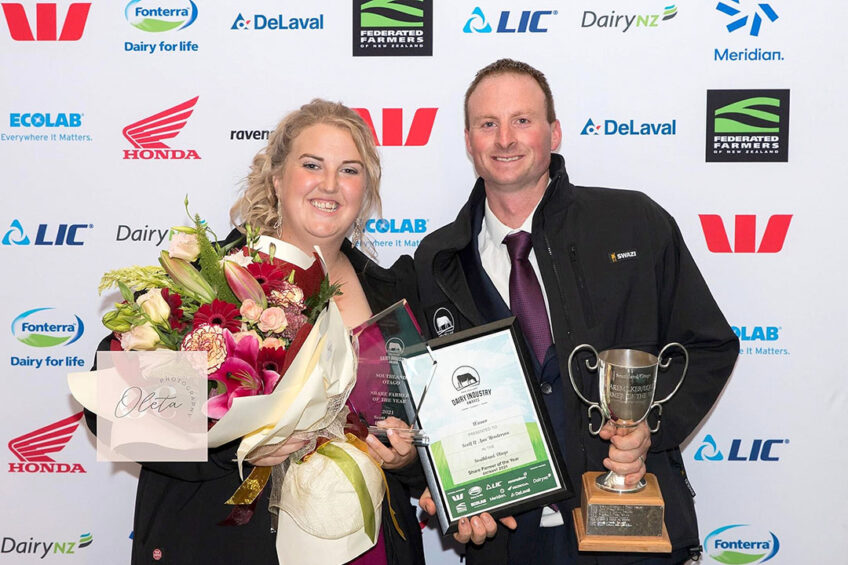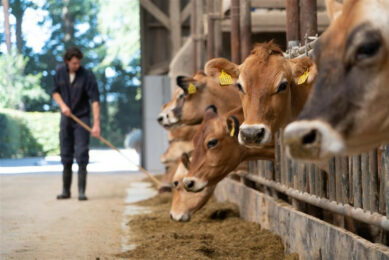Sharemilking success for dairy farm team

A Scottish-born woman and her New Zealander husband have just won a big award for their sharemilking business in New Zealand.
Born and bred on a beef and sheep farm at Fauldhouse, West Lothian, Ann Henderson and her husband Scott from South Otago have won the Southland-Otago Dairy Industry Awards Share Farmer of the Year for 2021.

Back in 2012 at the age of 21 and after spending a few years milking cows in South Lanarkshire, Ann was lured to New Zealand to gain more experience in dairying.
There she met carpenter and future husband Scott Henderson who eventually started working on various Kiwi farms before the couple joined forces in 2017 sharemilking on the same farm they work today.

Owned by the Whitestone Trust, the farm Ann and Scott work on is based in South Otago and extends to 560 hectares, of which 340 hectares is the milking platform.
Ann says: “It has been a dairy farm for the past 23 years and we are currently on a 3-year 25% sharemilking contract. We already own some cows in the herd but it is our ambition to own the full herd by 1 June 2022 and enter into a 50:50 sharemilking contract.
“Scott and I have our company Way2Milk Dairies. On this farm we are semi self-contained, so we have 850 milking cows, 210 calves and 210 yearlings, 60 empty carryover cows and aim to run 2.5 cows per hectare.
“The farm is rolling to steep contour with main soil types Waitahuna, Warepa and Tauratu, which are all clay based. Our annual rainfall is about 820mm per year.”

Milk goes to Danone
“Our milk goes to Danone to produce baby formula. Danone fixes half its payout for 2 years and the other half floats on Fonterra. We milk cows from July 20 to May 31, after that they are dried off. Half the cows, with the yearlings and calves, winter on the farm and the other half go to grazing.
“Our yearly production target is 320,000kg, but this year we are on track to do a record production of 345,000kg,” she said.
“Cows feed on grass during the milking period, along with 235kg of barley each per year to help the energy intake,” said Ann. “We make as much silage as the weather allows us to each year which can be very variable depending on the climate. This year we made 250 tonnes Dry Matter but last year was 80 tonnes so we do have to buy some in.
“Cows are fed 19kg DM during the milking season. Today we feed 1kg barley, 6kg silage and 12kg grass. We measure grass weekly with a plate metre to record growth rate, pasture cover, which allows us to make decisions early,” she adds.

The couple plant 30ha of fodder beet to winter the cattle on and make 1,000 bales of baleage either made on farm or bought in. A further 20ha of summer turnips are fed at 4kgs/cow from early January to March.
“The milking parlour is a 60 unit rotary with ACRs, auto drafting and teat spraying. We milk twice a day from August until Christmas then we go to 10:7 milking which means milking at 4.30am and 3pm on a Monday, Wednesday, Friday and then milk 8am on a Tuesday, Thursday, Saturday, and 6am on a Sunday.
“We own 365 cows now and will buy 370 in May 2021 and 370 in May 2022 aiming to be in a 50:50 partnership by June 2022,” says Ann.

The cows are kept outdoors all year round, and there is a calving pad that holds 250 cows. AI is used across the herd first and then Hereford bulls sweep up. The Hendersons rear 23% replacements each year and a Jersey bull is used on the yearling heifers.
She says: “We employ 3 full time staff, a Chilean, a New Zealander and a Filipino, who all have their own house on the farm and are treated as our family. We have weekly meetings to cover everything that is happening on farm and what is coming up.”
Diseases and lameness are the biggest problem on the farm for Ann and Scott with M Bovis posing the biggest threat.
“Our farm got taken out in 2019, which was devastating, but it opened up the opportunity for us to share milk,” states Ann. “Farming is hard and when huge events like that happen, it is soul-destroying but talking is key. Mental health and wellbeing are key and we do everything we can to look after ourselves, our team, and the community around us.”

“In our 25% contract, we pay for the labour, electricity, shed chemicals and rubberwear, gear and maintenance, as well as 25% of the in-shed feeding. The farm owner pays the rest. In return, we receive 25% of the milk cheque. In a 50:50 arrangement, all costs and income are split equally.
“The next goal for us is 50:50 share milking and then to buy a farm with 600 cows within 10 years,” she adds.
“Winning the competition has been invaluable to us as the contacts we have made and the publicity we have had from it has been huge. Now we go on to the nationals on May 15 to compete against all regional winners,” Ann says.
Join 13,000+ subscribers
Subscribe to our newsletter to stay updated about all the need-to-know content in the dairy sector, two times a week.










